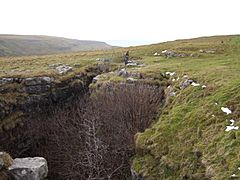Rowten Pot facts for kids
Quick facts for kids Rowten Pot |
|
|---|---|

Entrance shaft looking south
|
|
| Location | Kingsdale, North Yorkshire, UK |
| OS grid | SD 6982 7803 |
| Depth | 105 metres (344 ft) |
| Length | 259 metres (850 ft) |
| Discovery | first descent July 1897 |
| Geology | Carboniferous limestone |
| Difficulty | Grade 4 |
| Hazards | water, verticality |
| Access | Free |
| Cave survey | cavemaps.org |
Rowten Pot is a famous cave in North Yorkshire, England. It's one of many entrances to a huge underground cave system that stretches for about 27 kilometers (17 miles) under a valley called Kingsdale. The entrance to Rowten Pot is a large hole, or shaft, that is about 27 meters (89 feet) long and 10 meters (33 feet) wide. At its deepest point, it goes down 72 meters (236 feet)!
Exploring Rowten Pot
A small stream flows into the cave near the top. Most of Rowten Pot goes straight down, like a giant well. At the very bottom, the stream flows into an underground river called the West Kingsdale river. This river connects to the main Kingsdale Master Cave through three short underwater tunnels, called sumps.
If you go upstream (against the flow) from Rowten Pot, there are longer sumps that go for over 1 kilometer (0.6 miles). These tunnels pass under another cave called Aquamole Pot.
Cavers, who are people who explore caves, love Rowten Pot. They usually explore it using special climbing ropes and techniques. The cave is very spacious and has many different paths to explore high up in the shafts. The three short sumps that connect to the Kingsdale Master Cave can be explored by free-diving, which means swimming underwater without breathing equipment.
The water that flows into Rowten Pot actually comes from another nearby cave system called Rowten Caves. This system is about 150 meters (490 feet) west of Rowten Pot. Water goes into Rowten Caves and then flows underground, eventually coming out a few meters below the ground inside Rowten Pot.
Other caves in the area that also connect to the West Kingsdale System include Swinsto Cave, Simpson Pot, and Valley Entrance.
History of Rowten Pot
People have known about Rowten Pot for a very long time. The first written description of the cave was in a poem from 1781! It described the cave as a "dreadful yawn" and a "vast, dismal, dark and wide" place with a "rapid stream" flowing into it.
In 1865, a guide book mentioned someone named Mr. Hunter who claimed to have explored the whole cave. However, his story was probably not true. It's more likely that people had only gone down the gully (a narrow valley or channel) at the start of the cave.
A more accurate description appeared in 1890, where the cave was called by different names like Rowantree Gulf and Rowting Hole. The author of that book, Balderstone, said he explored down the gully for about 30 meters (98 feet).
The first time anyone fully explored Rowten Pot all the way to the sump (the underwater tunnel) was in June 1897. This was done by a group called the Yorkshire Ramblers' Club. However, it wasn't connected to the Kingsdale Master Cave until July 1966, after the Kingsdale Master Cave itself was discovered.
Over the years, accidents in caves like Rowten Pot have helped make caving safer. For example, in 1939, a challenging rescue took place in Rowten Pot when cavers were trapped by rising water. The BBC even asked for help from other cave explorers!
Later, in 1989, an accident happened because an anchor (a piece of equipment used to secure ropes) on the entrance shaft was old and worn out. This incident led to important changes in caving safety. It helped push for the development and installation of strong, permanent anchors in popular caves all over the UK, making them much safer for explorers today.

